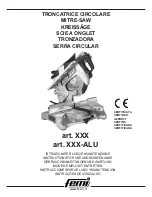
9
English
2. Adjusting the angle of inclination
By loosening the wing bolt at the scale, the saw
blade can be titled up to maximum angle of 45°
against the base (
Fig. 3
).
The angle of inclination can also be regulated by
loosening the wing bolt at the scale (
Fig. 3
).
CAUTION
It is very hazardous to allow this wing bolt to
remain loosened. Always thoroughly clamp it.
3. Regulating the guide
The cutting position can be regulated by moving
the guide to the left or right after loosening its wing
bolt.
The guide can be mounted on either the left or the
right side.
4. Fine tuning of parallelism
It is possible to fine-tune the parallelism of the saw
blade to the base using the parallelism adjustment
screw.
Adjustment has already been made at the time of
shipment from the factory. However, in the unlikely
event of parallelism being faulty, adjust as follows.
(1) Unfasten only the mounting screws of the saw
cover hinge portion (
Fig. 4
).
(2) Retract the protective cover into the saw cover.
(3) Insert wood chip in the rear side of the saw
blade base, and mark the position on the base
(
Fig. 5
).
(4) Move the marked wood chip to the front of the
base, and turn the parallelism adjustment screw
so that the marking corresponds to the base side
(
Fig. 6
).
(5) After adjustment, fasten the mounting screws
tightly in place.
NOTE
䡬
Parallelism may be slightly faulty if the cutting
depth is adjusted after parallelism adjustment.
CUTTING PROCEDURES
1. Place the saw body (base) on the lumber, and align
the cutting line with the saw blade at the front scale
(
Fig. 7
).
2. Turn ON the switch before the saw blade contacts
the lumber. The switch is turned ON when the trigger
is squeezed, and turned OFF when the trigger is
released.
CAUTIONS
Prior to cutting operation, make sure the material you
are going to cut. If the material to be cut is expected to
generate harmful / toxic dusts, make sure the dust bag or
appropriate dust extraction system is connected with
dust outlet tightly.
Wear the dust mask additionally, if available.
䡬
Before starting to saw, confirm that the saw blade
has attained full-speed revolution.
䡬
Should the saw blade stop or make an abnormal
noise while operating, promptly turn OFF the switch.
䡬
Always take care in preventing the power cord from
coming near to the revolving saw blade.
䡬
Using the circular saw with the saw blade facing
upwards or sideways is very hazardous. Such
uncommon applications should be avoided.
䡬
When cutting materials, always wear protective
glasses.
䡬
When finished with a job, pull out the plug from
the receptacle.
MOUNTING AND DISMOUNTING THE SAW
BLADE
CAUTION
To avoid serious accident, ensure the switch is in the
OFF position, and the power source is disconnected.
1. Dismounting the saw blade
(1) Set the cutting volume at maximum, and place the
Circular Saw as shown in
Fig. 8
.
(2) Depress the lock lever, lock the spindle, and remove
the hexagonal-head bolt with the box wrench.
(3) While holding the lower guard lever to keep the
lower guard fully retracted into the saw cover,
remove the saw blade.
2. Mounting the Saw Blade
(1) Thoroughly remove any sawdust which has accu-
mulated on the spindle, bolt and washers.
(2) As shown in
Fig. 9
, the side of Washer (A) with
a projected center the same diameter as the inner
diameter of the saw blade and the concave side
of Washer (B) must be fitted to the saw blade sides.
*
Washer (A) is supplied for 2 types of saw blades
with the hole diameters of 20 mm and 30 mm.
(When buying the Circular Saw, one type of
washer (A) is supplied.)
In case the hole diameter of your saw blade
does not correspond to that of washer (A), please
contact the shop where you purchased the Cir-
cular Saw.
(3) To assure proper rotation direction of the saw blade,
the arrow direction on the saw blade must coincide
with the arrow direction on the saw cover.
(4) Using the fingers, tighten the hexagonal-head bolt
retaining the saw blade as much as possible. Then
depress the lock lever, lock the spindle, and thor-
oughly tighten the bolt.
CAUTION
After having attached the saw blade, reconfirm that the
lock lever is firmly secured in the prescribed position.
MAINTENANCE AND INSPECTION
1. Inspecting the saw blade
Since use of a dull saw blade will degrade efficiency
and cause possible motor malfunction, sharpen or
replace the saw blade as soon as abrasion is noted.
2. Inspecting the mounting screws
Regularly inspect all mounting screws and ensure
that they are properly tightened. Should any of the
screws be loose, retighten them immediately. Fail-
ure to do so could result in serious hazard.
3. Maintenance of the motor
The motor unit winding is the very “heart” of the
power tool.
Exercise due care to ensure the winding does not
become damaged and/or wet with oil or water.
4. Inspecting the carbon brushes
For your continued safety and electrical shock
protection, carbon brush inspection and replacement
on this tool should ONLY be performed by a Hitachi
Authorized Service Center.
5. Replacing supply cord
If the supply cord of Tool is damaged, the Tool
must be returned to Hitachi Authorized Service
Center for the cord to be replaced.
01Eng_C6MFA_WE
2/27/09, 11:58
9











































